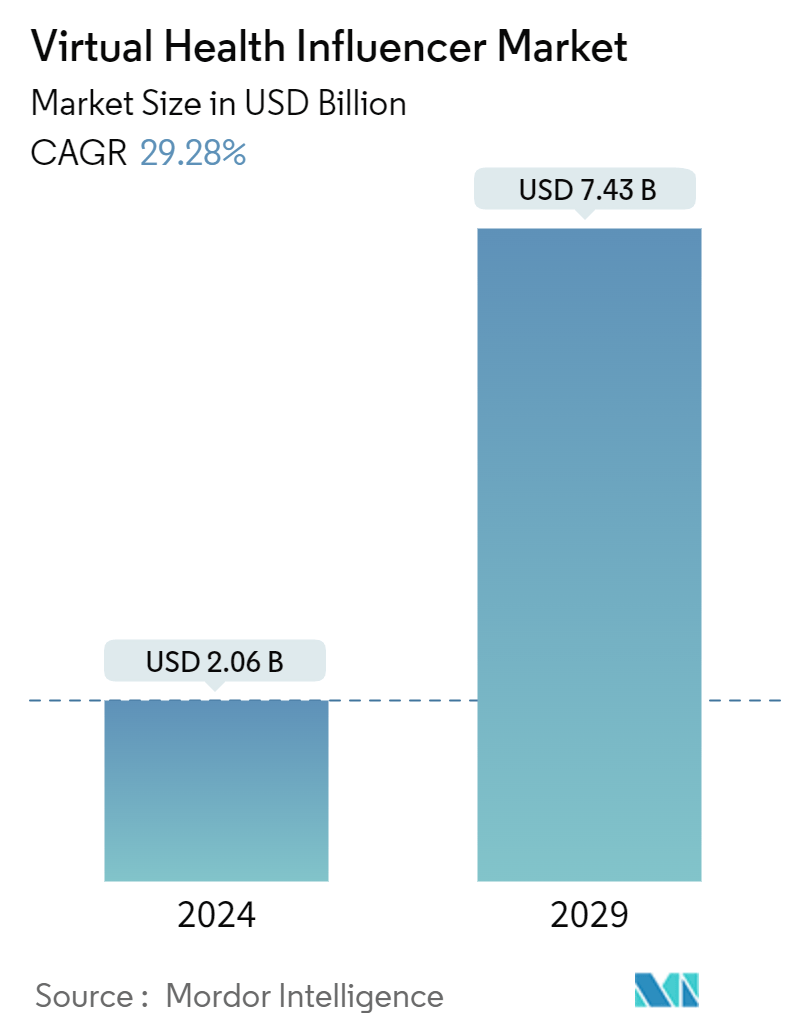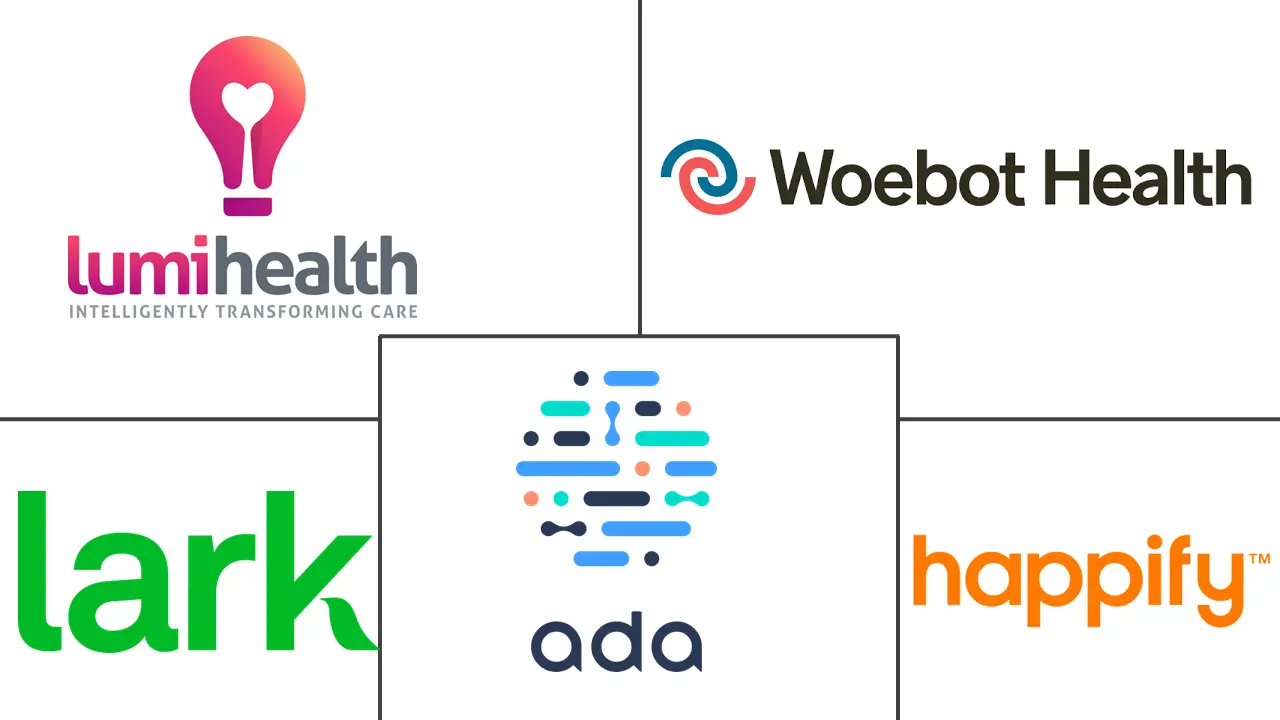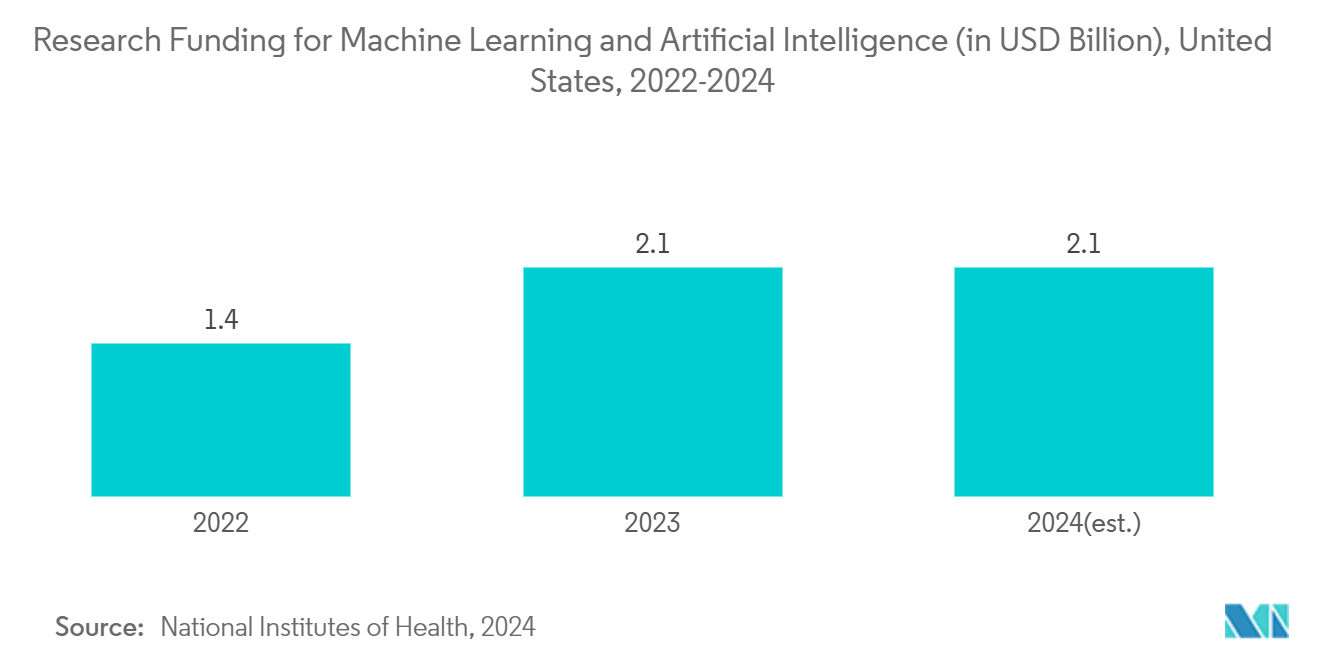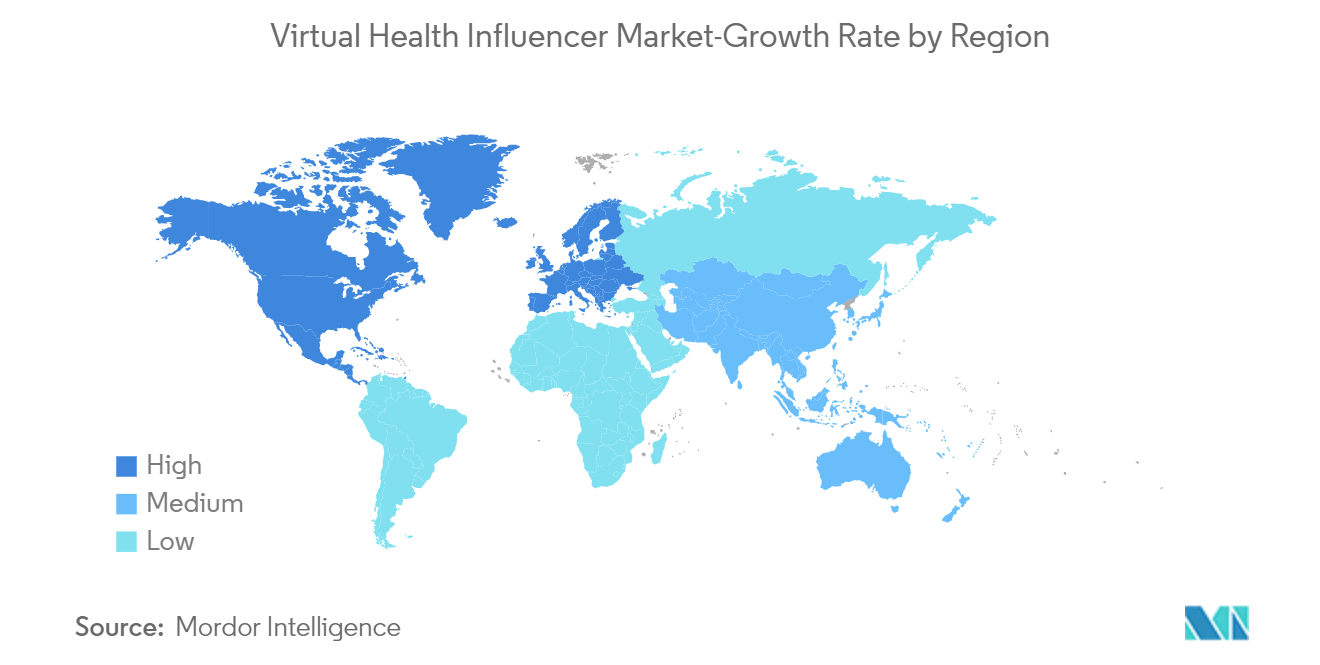Virtual Health Influencer Market Size

| Study Period | 2019 - 2029 |
| Market Size (2024) | USD 2.06 Billion |
| Market Size (2029) | USD 7.43 Billion |
| CAGR (2024 - 2029) | 29.28 % |
| Fastest Growing Market | Asia Pacific |
| Largest Market | North America |
| Market Concentration | Low |
Major Players
*Disclaimer: Major Players sorted in no particular order |
Virtual Health Influencer Market Analysis
The Virtual Health Influencer Market size is estimated at USD 2.06 billion in 2024, and is expected to reach USD 7.43 billion by 2029, at a CAGR of 29.28% during the forecast period (2024-2029).
Key drivers of the market include the ongoing digital transformation in healthcare, heightened global health awareness, increased internet usage, personalized healthcare content, and rapid technological advancements.
As internet adoption surges worldwide, virtual health influencers are expanding their reach, boosting patient engagement on social media, websites, and apps. This trend is set to propel the market during the forecast period. For example, a March 2023 update from Our World in Data highlighted that approximately 5.35 billion people, or 67% of the global population, accessed the internet. Such widespread internet access is likely to bolster the adoption of mobile applications centered around virtual health influencers, further fueling the market's growth.
Additionally, technological advancements in virtual health influencer technologies are anticipated to enhance their accessibility and affordability, further propelling the market. For instance, in June 2024, Wheel, a telehealth platform, unveiled its AI-driven solution, Horizon. This app not only provides insights into patient care but also eases the workload on providers. By aggregating data from patient profiles, labs, previous case notes, and remote monitoring, Horizon offers clinically relevant recommendations for both patients and providers. Such innovations are poised to boost the adoption of AI-centric virtual health influencers, driving the market's growth.
Furthermore, the increasing use of virtual health influencers to raise awareness about chronic diseases is set to bolster the market. An April 2024 article in Social Science noted that virtual influencers and AI doctors have notably heightened health awareness and cancer literacy among Chinese users. Given this, the pivotal role of virtual health influencers in chronic disease awareness, especially cancer, is likely to spur technology adoption and drive market growth.
In summary, global internet expansion, technological strides, and the pivotal role of virtual health influencers in chronic disease awareness are set to propel the market. However, concerns over trust and credibility may pose challenges.
Virtual Health Influencer Market Trends
AI-driven Avatars Segment is Expected to Hold Significant Market Share Over the Forecast Period.
A Digital Avatar is an AI-powered human-like virtual assistant that enables intelligent interactions with customers. 3D avatars can be used for different purposes, and they create a sense of trust by providing valuable health awareness information to customers directly and easily. The major factors driving the segment are the increasing adoption of AI-driven avatars in healthcare and
The increasing adoption of AI-driven avatars in healthcare is expected to increase the demand for this technology and drive the studied segment over the forecast period. For instance, according to the article published in Technological Forecasting and Social Change in March 2024, AI-driven avatar influencers represent a new way to create awareness about diseases in healthcare, avoiding the risks and tensions associated with human influencers. Another benefit is also to reduce anxiety and frustrations caused by the status and physical appearance of human influencers. Hence, the increasing adoption of AI-driven avatars in healthcare is expected to drive the studied market over the forecast period.
Moreover, technological strides in AI-driven avatars are broadening their accessibility, further propelling market growth. For instance, in April 2024, the World Health Organization (WHO) unveiled 'S.A.R.A.H.', a prototype digital health promoter. Powered by generative AI, S.A.R.A.H. boasts an advanced empathetic response. This Smart AI Resource Assistant for Health, a leap forward in AI health information avatars, utilizes state-of-the-art language models. It offers round-the-clock engagement in eight languages across diverse health topics, accessible on any device. Such innovations not only enhance the reach of AI-driven avatars but also bolster segment revenue.
In conclusion, the dual forces of heightened adoption of AI-driven avatars for disease awareness and ongoing technological advancements are set to propel segment revenue in the coming years.

North America is Expected to Hold the Significant Market Share Over the Forecast Period
In North America, the virtual health influencer market is propelled by the rising prevalence of chronic diseases, a robust healthcare infrastructure, the digital transformation of healthcare, and strategic maneuvers by key market players.
As North America's healthcare sector embraces digitalization, there's a surge in the use of virtual health applications. These platforms play a pivotal role in raising awareness about chronic ailments like diabetes, hypertension, and obesity, thereby bolstering the market's growth. For instance, the Canadian Digital Health Survey from April 2024, based on an online survey conducted in November 2022 with 12,445 Canadians nationwide, revealed that a significant 94% of Canadians showed interest in digital health services. This underscores the momentum of digital healthcare in Canada and its potential to fuel market growth.
Moreover, heightened strategic endeavors, particularly investments in pioneering technologies within the virtual health domain, are set to broaden the reach of these innovations, further propelling market growth. For instance, in August 2024, Fractal, renowned for its AI and advanced analytics solutions, unveiled vaidya.ai. This healthcare AI platform aims to democratize healthcare access, offering complimentary assistance. It can interpret health reports, answer queries in multiple languages, and provide context-specific information. Hence, the launch of such technologies is expected to increase the accessibility of virtual health assistants and drive the studied market over the forecast period.
Hence, the increasing adoption of digital health solutions and the rising strategic activities by the key players are expected to drive the studied market over the forecast period in North America.

Virtual Health Influencer Industry Overview
The virtual health influencer market is fragmented due to the presence of many global and regional players in the field. The major players in the market are adopting various strategic activities such as mergers, collaborations, and raising funds for new solutions development. Some of the key players in the market are Lumi Health Inc, Woebot Health, Ada Health GmbH, Lark Health, and Happify, among other players.
Virtual Health Influencer Market Leaders
-
Lumi Health Inc
-
Woebot Health
-
Ada Health GmbH
-
Happify
-
Lark Health
*Disclaimer: Major Players sorted in no particular order

Virtual Health Influencer Market News
- July 2024: DocVA, a virtual medical assistant staffing company, reported the launch of its comprehensive suite of remote healthcare support services. This offering aims to transform medical practices by providing highly skilled virtual assistants capable of handling various administrative and clinical support tasks.
- April 2023: TeleVox, a provider of omnichannel digital patient technology, reported the launch of Iris, an AI-driven virtual agent accessible via web, voice, and SMS interactions and embedded into HouseCalls Pro patient engagement workflows. Iris provides patients with quick access to information and easy completion of common tasks, improving patient access and self-service.
Virtual Health Influencer Market Report - Table of Contents
1. INTRODUCTION
1.1 Study Assumptions and market definitions
1.2 Scope of the Study
2. RESEARCH METHODOLOGY
3. EXECUTIVE SUMMARY
4. MARKET DYNAMICS
4.1 Market Overview
4.2 Market Drivers
4.2.1 Increasing Utilization of Internet
4.2.2 Rising Technological Advancements
4.3 Market Restraints
4.3.1 Lack of Trust and Credibility
4.4 Porter's Five Force Analysis
4.4.1 Threat of New Entrants
4.4.2 Bargaining Power of Buyers/Consumers
4.4.3 Bargaining Power of Suppliers
4.4.4 Threat of Substitute Products
4.4.5 Intensity of Competitive Rivalry
5. MARKET SEGMENTATION (Market Size by Value - USD)
5.1 By Technology
5.1.1 Augmented Reality(AR)
5.1.2 Virtual Reality (VR)
5.1.3 Chats and Virtual Assistants
5.2 By Type
5.2.1 AI-Driven Avatars
5.2.2 Mixed Reality Influencers
5.2.3 Digital Humans
5.3 By Platform
5.3.1 Social Media
5.3.2 Websites and Blogs
5.4 Geography
5.4.1 North America
5.4.1.1 United States
5.4.1.2 Canada
5.4.1.3 Mexico
5.4.2 Europe
5.4.2.1 Germany
5.4.2.2 United Kingdom
5.4.2.3 France
5.4.2.4 Italy
5.4.2.5 Spain
5.4.2.6 Rest of Europe
5.4.3 Asia-Pacific
5.4.3.1 China
5.4.3.2 Japan
5.4.3.3 India
5.4.3.4 Australia
5.4.3.5 South Korea
5.4.3.6 Rest of Asia-Pacific
5.4.4 Middle East and Africa
5.4.4.1 GCC
5.4.4.2 South Africa
5.4.4.3 Rest of Middle East and Africa
5.4.5 South America
5.4.5.1 Brazil
5.4.5.2 Argentina
5.4.5.3 Rest of South America
6. COMPETITIVE LANDSCAPE
6.1 Company Profiles
6.1.1 Lumi Health Inc
6.1.2 Woebot Health
6.1.3 Ada Health GmbH
6.1.4 Replika
6.1.5 llo Health
6.1.6 Lark Health
6.1.7 Happify
6.1.8 Myndlift
6.1.9 Lively
- *List Not Exhaustive
7. MARKET OPPORTUNITIES AND FUTURE TRENDS
Virtual Health Influencer Industry Segmentation
As per the scope of the report, a virtual health influencer is a computer-generated character designed to interact with and engage audiences on social media platforms. These digital avatars are entirely fictional and are created using technology such as artificial intelligence (AI). The virtual health influencer market is segmented into technology, type, platform, and geography. By technology, the market is segmented into augmented reality (AR), virtual reality (VR), and chats and virtual assistants. By type, the market is segmented into AI-driven avatars, mixed reality influencers, and digital humans. By platform, the market is segmented into social media, websites, and blogs. By geography, the market is segmented into North America, Europe, Asia-Pacific, Middle East and Africa, and South America. The market report also covers the estimated market sizes and trends for 17 countries across major regions globally. The report offers values (in USD) for the above segments.
| By Technology | |
| Augmented Reality(AR) | |
| Virtual Reality (VR) | |
| Chats and Virtual Assistants |
| By Type | |
| AI-Driven Avatars | |
| Mixed Reality Influencers | |
| Digital Humans |
| By Platform | |
| Social Media | |
| Websites and Blogs |
| Geography | ||||||||
| ||||||||
| ||||||||
| ||||||||
| ||||||||
|
Virtual Health Influencer Market Research FAQs
How big is the Virtual Health Influencer Market?
The Virtual Health Influencer Market size is expected to reach USD 2.06 billion in 2024 and grow at a CAGR of 29.28% to reach USD 7.43 billion by 2029.
What is the current Virtual Health Influencer Market size?
In 2024, the Virtual Health Influencer Market size is expected to reach USD 2.06 billion.
Who are the key players in Virtual Health Influencer Market?
Lumi Health Inc, Woebot Health, Ada Health GmbH, Happify and Lark Health are the major companies operating in the Virtual Health Influencer Market.
Which is the fastest growing region in Virtual Health Influencer Market?
Asia Pacific is estimated to grow at the highest CAGR over the forecast period (2024-2029).
Which region has the biggest share in Virtual Health Influencer Market?
In 2024, the North America accounts for the largest market share in Virtual Health Influencer Market.
What years does this Virtual Health Influencer Market cover, and what was the market size in 2023?
In 2023, the Virtual Health Influencer Market size was estimated at USD 1.46 billion. The report covers the Virtual Health Influencer Market historical market size for years: 2019, 2020, 2021, 2022 and 2023. The report also forecasts the Virtual Health Influencer Market size for years: 2024, 2025, 2026, 2027, 2028 and 2029.
Virtual Health Influencer Industry Report
Statistics for the 2024 Virtual Health Influencer market share, size and revenue growth rate, created by Mordor Intelligence™ Industry Reports. Virtual Health Influencer analysis includes a market forecast outlook for 2024 to 2029 and historical overview. Get a sample of this industry analysis as a free report PDF download.



